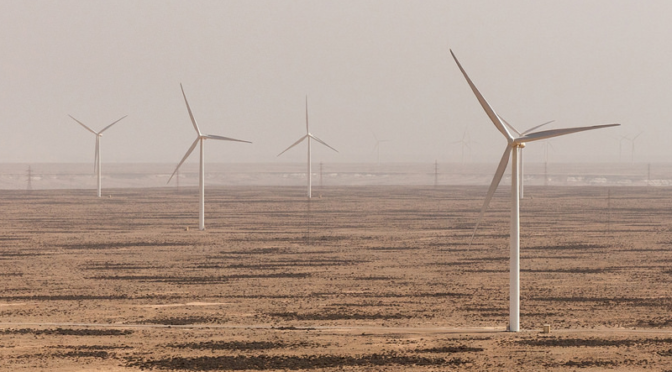Renewable energy projects, including wind power, can be a model for the economic integration for southern Morocco and northern Mauritania.
Although energy has become a strategic factor in economic development, Morocco remains largely dependent on the international energy market, as it imports more than 90% of its energy needs.
To reduce its energy dependence, Morocco adopted a new energy strategy in 2009 to increase the share of renewable energies in the mixed electrical power installed to 52% by 2030. Its strategic location allows Morocco to be an electrical hub between Europe and Africa.
While achieving energy security has been a top priority for Morocco through the last ten years, the current high gas prices due to the Russia-Ukraine conflict have greatly increased the national energy bill, highlighting the need for Morocco to adopt a more self-sufficient energy policy.
A growing sustainability portfolio
Renewable energy projects in Morocco are possible due to the establishment of an appropriate legislative, regulatory and institutional framework. As Morocco continues to update its energy initiatives, in order to make the renewable energy sector more attractive to private investment, it has become among the leaders of renewable energies in Africa, alongside South Africa and Egypt.
Morocco has also developed an integrated water desalination program featuring power plants backed by renewable energy production units, as well as an ongoing preparation of a marine energy roadmap.
As the south of Morocco benefits from an exceptional resource of renewable energy, the next decade will witness the development of a large portfolio of wind projects in this region. The transport of this energy to the centers of consumption, however, requires the reinforcement of the 400kV alternating current network in southern Morocco and the subsequent increase in the transit capacity of this network.
Regional electrical connection
As for Mauritania, the increase in electricity consumption has prompted the West African countries to take a greater interest in the development of the production of electricity through renewable resources. Wind technologies will aim to produce 129 MW by 2030 in Mauritania.
Since 1997, the Moroccan electricity national network has been connected to its Spanish counterpart, its continental connection with the Mauritanian national network will constitute a regional electricity integration model which will contribute to the economic development of Atlantic Africa.
Mauritania shares similar wind resources with southern Morocco, particularly the northern coastal zone. The installed wind power in Mauritania is 34.4MW. The renewable energy projects, including wind power, can thus serve as a model for the integration of green energy in the South of Morocco and North of Mauritania.
Wind power potential
The study of the wind speed and the evaluation of the wind potential at a given site depends on the period and the step of measurements, thus the amplitude and the nature of the variation of wind speed. For example, for the site of Tangier in Northern Morocco, the assessment of wind potential requires four measurements of wind speed per day (0h, 6h, 12h and 18h) for a minimum of nine years
In the south of Morocco, August and July are the windiest months for Laâyoune and Dakhla, with monthly averages of 7.67m/s and 10.12m/s respectively. For Laâyoune, the maximum speed is 34 m/s, while it is 27 m/s for Dakhla. The variation in wind speed is more steady for the Dakhla site.
For the Moroccan village of Lagouira, June is the windiest month, where daily average wind speed is between 7.9 m/s and 10.7 m/s for 27 days. During December, however, the least windy month is only 5 days, but 19 days have an average between 5.4 m/s and 7.9 m/s.
For the majority of the considered sites, the wind speed is strong during the day and reaches its maximum around 4 p.m., local time, before becoming weak at night. The variation between the daytime and nighttime wind speeds can be primarily explained by the influence of the gradual rise in temperature over the course of the day on the Atlantic coast that causes local winds (sea/land breeze) to join the winds from the Azores.
The available wind potential is greater for the sites of Dakhla in southern Morocco and Nouadhibou in northern Mauritania, where a 100MW wind farm will be installed. For Dakhla, at an altitude of 10m, the annual average of available wind potential is the highest (P=462 W/m2), almost double that of Laâyoune and four times that of Tan Tan.
In 2021, total wind power installed in Morocco amounted to 1350 MW. More than 56% (757.3 MW) is located in the south of Morocco. Morocco’s Tarfaya wind farm (301.3 MW) installed in 2014 remains the largest wind farm in Africa. Total wind power in Mauritania is 34.4MW. The first 4.4MW park was installed in Nouakchott in 2011.
For the south of Morocco and the north of Mauritania, wind energy is a competitive energy alternative to petroleum products for the next generation of electricity.
The renewable energy projects, including wind power, is a model and an essential factor for the economic integration for southern Morocco and northern Mauritania. The development of wind energy has important economic and social implications for this region and will help the two countries become regional leaders in the field of renewable energies.
Hassan Nfaoui, moroccoworldnews.com


